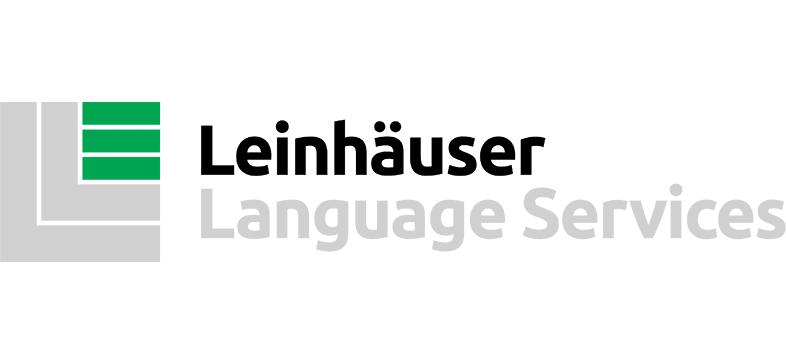Macklin GmbH merged with Leinhäuser on January 1, 2019. This turned out to be a shrewd move for both parties, as their complementary areas of expertise and similar service philosophy made them a perfect match. In short, they just made each other stronger and better prepared to tackle the challenges of the future.
In this interview, former Macklin Managing Director Claudia Link-Beier explains how it all came to pass, what sets Leinhäuser apart, and why every Leinhäuser service is a Business-to-Human (B2H) service.
When did you first come across Leinhäuser?
I met Heike Leinhäuser at a conference in Berlin for Qualitätssprachendienste Deutschlands e. V. (QSD) in 2005. At the time, she was Vice President of the association. Later, of course, she would go on to become President. I was immediately taken with the people I met at the conference, as well as QSD’s philosophy and open culture that thrives on partnership. I signed up there and then, and Heike and I have stayed in touch ever since, in both a professional and personal capacity.
What was the thinking behind the merger?
We quickly realized that we had a very similar business philosophy:
In addition to delivering top-quality language services, we both highly prioritize personal customer service.
And this remains the case today. Our approaches to work aligned as well: Just like Leinhäuser, my team at Macklin was also made up of linguists who, in addition to managing projects, served as a single point of contact for the customer throughout, from initial consultation right through to review and delivery. Our employees all got along well from the very start, and it was a stroke of luck that we both happened to be based in the Munich area.
Was there a specific reason for the merger?
Increasing levels of mechanization and automation in the language industry, coupled with ever-stricter regulatory requirements in terms of data protection, information security and compliance, call for significant investment of both time and money. It made sense to join up with another company and pool resources, and for me it had to be Leinhäuser.
What was the biggest challenge for your team?
We really had to hit the ground running, with ongoing contracts and projects that we had to seamlessly transfer from our Macklin systems over to the Leinhäuser IT setup. Thanks to the very generous support of our new colleagues at Leinhäuser, however, it was quite the tour de force and we quickly found our feet.
What was the biggest challenge for you?
I had spent my whole working life at Macklin, so it was a massive change for me to move into an unfamiliar environment after 30 years and leave the past behind – literally and figuratively. On top of that, Leinhäuser was in the midst of expanding and renovating their premises, so my new office was still a work in progress, and I started out in a makeshift one instead. But none of this really mattered as we were welcomed with open arms and immediately felt at home in this warm and inspiring space. It was a clear win-win all round.
Was the merger fundamental to Leinhäuser’s future plans?
It was definitely in keeping with Leinhäuser’s growth strategy. We brought new skills to the table, but we also learned a great deal from the Leinhäuser teams in return. And we both had the same basic belief:
We give all our employees the opportunity to develop and grow.
How would you define the Leinhäuser spirit?
It really is something very special that you just feel straight away, because we all – the management team included – walk the talk. We are an eclectic mix of characters, cultures and mentalities, each one as friendly and brilliant as the next! We are also all passionate linguists who treat each other as equals and are always happy to celebrate success.
The Leinhäuser spirit is embodied by people who do their best every day, support each other and are there for each other. And who draw on imagination and creativity to make the impossible possible.
How is this sustained in times of remote working?
We have long forged successful partnerships with home-based freelancers all over the world, and since we expanded, we have more space for hot desking and flexible working. The pandemic has obviously been a huge challenge, but our determination to stay connected to our employees prompted our weekly virtual “jour fixe”.
This remains a regular fixture, and we use it as a forum to discuss topics that concern everyone, and for training purposes, but also as an opportunity to simply interact with each other. Particularly during the first lockdown, these get-togethers were an invaluable tool for us to gauge how people were coping with the added burden of things like homeschooling on top of working from home.
What do you see as the greatest challenge currently?
The tricky act of balancing automation with delivering a personal service certainly keeps us on our toes! We use tools where they deliver efficiency savings, but never at the expense of the quality of our services and the close relationships we have with our customers and service partners – this enables us to go that “extra mile” when necessary.
While we are well aware of the need for speed and efficiency, the personal touch is a priority for us too.
And the solution?
“Our customers know we are always there for them whenever they need us – each one has a dedicated team here that is familiar with their projects and on whom they can rely at any time.
We listen very carefully to understand exactly what our customers need. Yes, we have workflows in place, but we also allow plenty of room for improvisation and flair, to think outside the box and provide our customers with the bespoke solutions they require.








